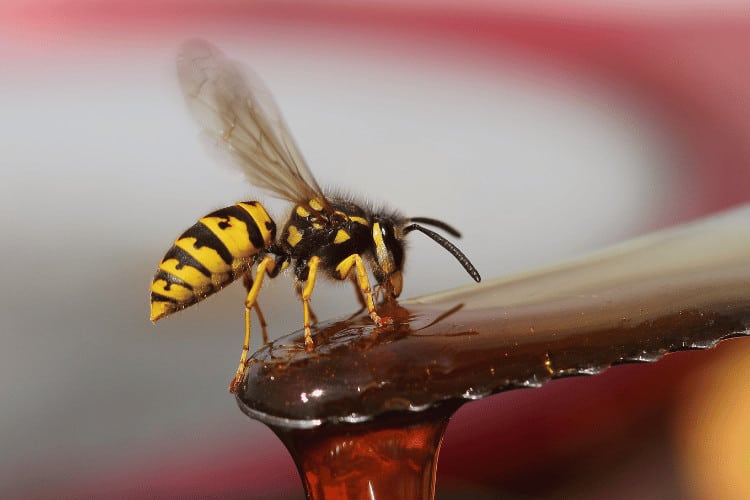Carpenter Bee vs. Yellow Jacket: A Comprehensive Comparison
Hey there, fellow bee enthusiasts!
If you’re delving into the world of beekeeping, it’s essential to distinguish between different types of stinging insects, like carpenter bees and yellow jackets.
These buzzers might seem quite similar at first glance, but they have distinct characteristics that set them apart. This carpenter bee vs. yellow jacket comparison guide highlights all of these key differences, so stick around.
Overview of Yellow Jackets

Yellow jackets are a type of wasp that often triggers images of buzzing annoyance at picnics or outdoor gatherings. These social insects live in colonies, much like honeybees, forming intricate communities.
Unlike honeybees, however, yellow jackets aren’t exactly friendly and are known for their painful stings. These stings can cause discomfort and even allergic reactions in some individuals, so it’s crucial to be cautious around them.
Yellow jackets are recognizable by their vibrant yellow stripes and distinct body shape. Typically, they build their nests underground, in cavities, or in sheltered areas, crafting intricate paper-like nests using chewed-up wood fibers mixed with their saliva.
These nests can house hundreds of yellow jackets, and disturbing them can result in a swarm of agitated insects.
Overview of Carpenter Bees
On the other hand, we have carpenter bees, a species of bee that follows a different path in the insect world—a not-so-social one! These solitary insects might resemble bumblebees, but they have subtle differences that set them apart from other types of bees.
Carpenter bees are known for their impressive carpentry skills. They tend to burrow into wooden structures like decks, eaves, and even trees to create their nests.
However, don’t be quick to brand them as pests! These bees play a significant role in pollination and are essential contributors to ecosystem balance.
They don’t consume the wood. Instead, they excavate it to create galleries where they lay their eggs. You might spot small piles of sawdust beneath their nesting sites, which is a clear sign of their handiwork.
Carpenter Bees vs. Yellow Jackets: Key Differences

Now that you know a little bit about carpenter bees and yellow jackets, let’s talk about the main differences between them in more detail.
Social vs. Solitary Behavior
Yellow jackets are social insects that thrive in colonies, exhibiting an organized and cooperative lifestyle. Within their colonies, they have distinct roles such as workers, drones, and queens. In general, they’re far from solitary wasps!
In contrast, carpenter bees are solitary creatures, preferring to work independently without the support of a colony. Each female carpenter bee builds and maintains her own nest, showing a more self-reliant approach to life.
Stinging and Pollination
When it comes to stinging, yellow jackets are well-known for their aggressive nature and painful stings. Their venomous sting can lead to discomfort, allergic reactions, and even health risks for some individuals.
In the case of carpenter bees, females possess the ability to sting, but they are far less likely to do so unless they feel directly threatened.
These remarkable bees mainly focus on pollination and contribute positively to the environment by facilitating the reproduction of various plants and flowers.
Nesting Habits and Dynamics
Yellow jackets construct intricate nests using a paper-like material created from wood fibers and their saliva. These nests can be found underground, in wall voids, or hanging from eaves.
On the other hand, carpenter bees exhibit a distinct nesting habit involving wood. Rather than building paper nests, female carpenter bees tunnel into wood to create their nests, using their impressive carpentry skills to carve galleries for their eggs.
Yellow jacket colonies can house a large number of individuals, with hundreds to thousands of workers, drones, and a queen. Their social structure is all about intricate communication and cooperation to ensure the survival of the colony.
In contrast, carpenter bees do not form colonies. Instead, each female bee establishes her own nest and takes care of her offspring individually. This solitary behavior sets them apart from the communal nature of yellow jackets.
Aggression and Defensive Behavior
Yellow jackets are quite notorious for their aggressive behavior, especially when their nests are threatened. Their stings can be triggered by seemingly minor disturbances.
Carpenter bees, while capable of stinging, are generally much more docile. They are less likely to sting and typically only resort to it when they feel directly endangered. This makes carpenter bees less of a threat, especially when their nests are approached with care.
Appearance and Markings
Yellow jackets are easily recognizable because of their vibrant yellow and black striped pattern, which serves as a warning to potential predators about their stinging ability.
Carpenter bees often resemble bumblebees with their robust bodies. A key difference, however, is that carpenter bees lack the dense hair that characterizes bumblebees.
Additionally, while yellow jackets have a shiny and smooth appearance, carpenter bees tend to exhibit a slightly more textured body surface.
Ecosystem Contributions

Carpenter bees are valuable pollinators. They play an important role in plant reproduction by transferring pollen from one flower to another. This valuable process aids in the production of fruits, vegetables, and other crops.
Yellow jackets, while often considered nuisances due to their aggressive behavior, contribute to the ecosystem by scavenging on decaying matter and helping to control pest populations. Their scavenging habits assist in maintaining the balance of the ecosystem.
Wrapping Up
As beekeepers, understanding the main differences between carpenter bees and yellow jackets will empower you to approach each species with knowledge and respect.
By knowing their unique behaviors, roles, and contributions, you’ll be better equipped to coexist harmoniously with these intriguing members of the stinging insect world.
